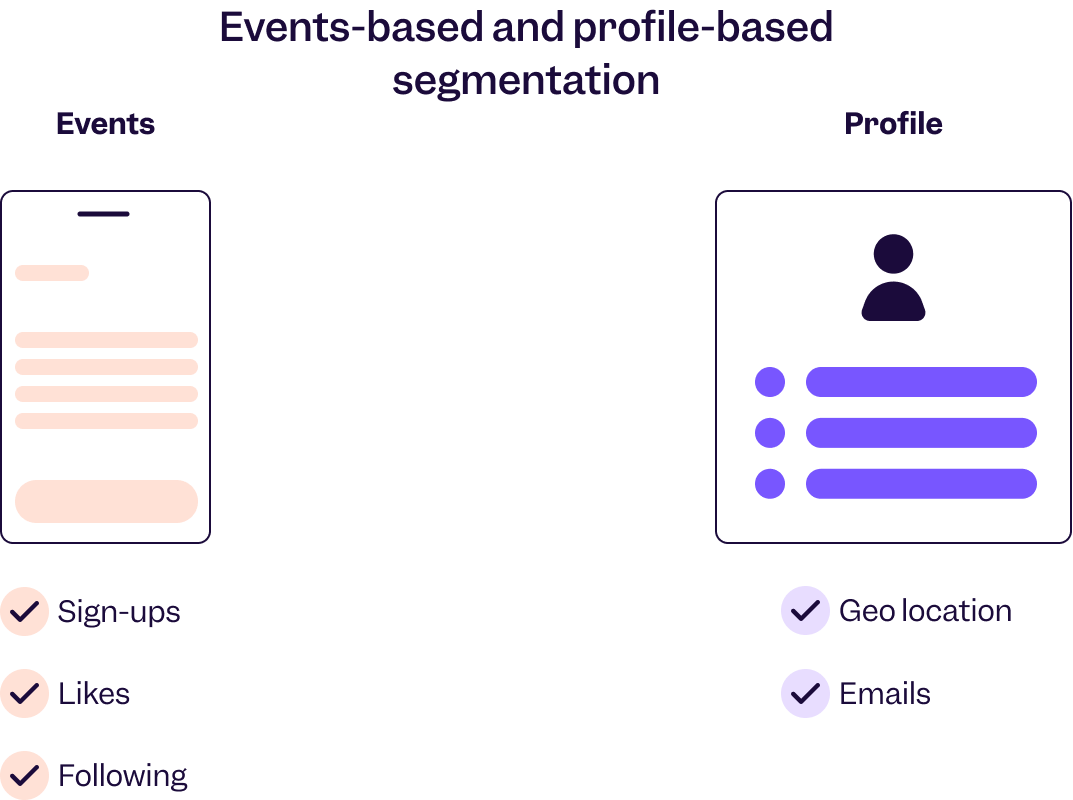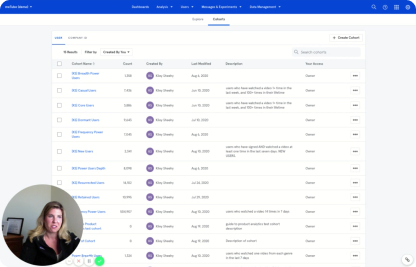What’s user segmentation
in product analytics?
If there’s one thing that product managers, regardless of their industry and location, 100% agree on, it is that to build great products, you need to understand your users. One of the first things that product managers do when they get into product analytics is to look at different user actions and then segment them by country, hoping to find some magical distinction. Are users in South Korea more active than in Mongolia? Such data is curious and potentially useful for marketing. But when it comes to making product decisions, data on what users actually do in your product (behavioral data) speaks volumes more about who people actually are than their demographics. Such insights are more actionable, because in-product behavior can be “nudged” — and changed — more easily than demographics.

User segmentation in product analytics is grouping users based on their demographics or behavior in order to establish a baseline for analysis.
Mixpanel was built to help product managers understand user behavior. However, it lets you easily organize and analyze any user segment — behavioral (event-based) or demographic (profile-based).
How does it work?

In Mixpanel, each data point is connected to a single user through a unique ID. Events are interactions between a user and your product. These are things users do, like signing up, adding items to cart, liking and following. Profiles store information about who your users are, like where they live (geo), and what email they use to log in.
What’s DAU/ WAU/ MAU?
Not all behavioral insights are equally actionable. Take DAU (daily active users), WAU (weekly active users), and MAU (monthly active users), the industry’s most popular product metrics. These metrics are used to draw a simple distinction: are my users active or not?
If you know what “active” means for your business, getting this data is easy with product analytics. Below, we explain:
- How to define and measure DAU/WAU/MAU
- The pitfalls of measuring active usage
- When to use DAU/WAU/MAU (and when not to)
Defining “active usage”
When calculating your DAU, WAU, or MAU,
remember that A stands for “Active”
Some companies consider an active user to be someone who simply accesses the site or app. This approach is simple but flawed, because it creates a distorted perspective of user engagement. Obviously, not every user who logs into your app ends up engaging with your product in a meaningful way. A better way to calculate active usage is to look only at users who find value in your product (daily, weekly, or monthly).
Examples of DAU/WAU/MAU
Facebook, for example, defines an active user as someone who has interacted with the site by “liking, sharing, commenting, or clicking through another link.”² At Mixpanel, we consider customers to be “active” when they use our product analytics platform to analyze user behavior. The primary way to do that in Mixpanel is through what we call “segmentation” (i.e., our active users are those who “filter by” or “breakdown by” in their queries).
Monetizable “active usage”
Even though “active usage” should ideally be tied to “value moments” in your product, they are not the same metrics. As with any metric, the definition of “active users” is ultimately what a company internally decides “active users” should be in their business’s specific context. That means sometimes “active usage” is based on “value exchange moments” instead of “value moments.”
An example is the mDAU metric, which stands for monetizable daily active usage. Twitter defines monetizable active users as “users who logged in or were otherwise authenticated and accessed Twitter on any given day through twitter.com or Twitter applications that are able to show ads.”³ This metric doesn’t reflect the product’s value moments for Twitter users (which could be when a user learns “what’s happening” — through retweets, replies “@”, or follows) and shouldn’t be top of mind when building a value-first product. However, it’s an important KPI for tracking the value of Twitter for advertisers.
When should I measure DAU/WAU/MAU?
Because active usage is such a popular KPI, it often becomes the default metric for all types of product analyses, including industry benchmarking, product growth, marketing campaign performance, and the like. Let’s look at some of the ways DAU/WAU/MAU are used, so you can assess when these metrics serve you well (and when they don’t).
How can I measure my
DAU/WAU/MAU count?
To get your daily, weekly or monthly user count in Mixpanel and monitor it over time, follow these three simple steps:
- In the Insights report, select an event that your active users should be doing (e.g., “watch video”).
- Highlight “Total” to bring up all the different ways you can group your users, including Total per User, Unique, and DAU/WAU/MAU. Select “WAU” for weekly active users.
- Customize the date range. Mixpanel will default your line graph over time to a lookback of the last 30 days (from the active day) and a day-by-day count.
When it comes to measuring active
usage, what’s the difference between
a good PM and a great PM?
A good PM knows what constitutes active behavior in their DAU/WAU/MAU definition to ensure they are tracking the right thing.
A great PM finds what user actions correlate with the “A” in their DAU, and makes product adjustments to encourage those actions early on and in more users.
2. Tardi, Carla. Monthly active users (MAU) (2015, April 6). Investopedia.
https://www.investopedia.com/terms/m/monthly-active-user-mau.asp
3. Twitter Q1 2019 Earnings Report.
https://s22.q4cdn.com/826641620/files/doc_financials/2019/q1/Q1-2019-Slide-Presentation.pdf
![pa-img02[1]](https://mixpanel.com/wp-content/uploads/2020/09/pa-img021-1.png)

